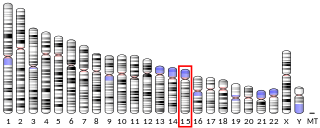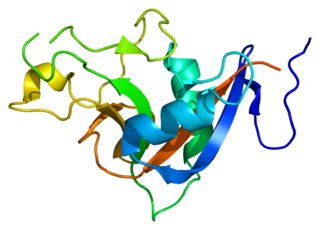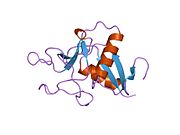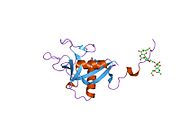
Membrane alanyl aminopeptidase also known as alanyl aminopeptidase (AAP) or aminopeptidase N (AP-N) is an enzyme that in humans is encoded by the ANPEP gene.

Amylin, or islet amyloid polypeptide (IAPP), is a 37-residue peptide hormone. It is co-secreted with insulin from the pancreatic β-cells in the ratio of approximately 100:1 (insulin:amylin). Amylin plays a role in glycemic regulation by slowing gastric emptying and promoting satiety, thereby preventing post-prandial spikes in blood glucose levels.

Chromogranin A or parathyroid secretory protein 1 is a member of the granin family of neuroendocrine secretory proteins. As such, it is located in secretory vesicles of neurons and endocrine cells such as islet beta cell secretory granules in the pancreas. In humans, chromogranin A protein is encoded by the CHGA gene.

GM2 ganglioside activator also known as GM2A is a protein which in humans is encoded by the GM2A gene.

Shekel Somatostatin receptor type 3 is a protein that in humans is encoded by the SSTR3 gene.

Cathepsin L1 is a protein that in humans is encoded by the CTSL1 gene. The protein is a cysteine cathepsin, a lysosomal cysteine protease that plays a major role in intracellular protein catabolism.

Pancreatic secretory trypsin inhibitor (PSTI) also known as serine protease inhibitor Kazal-type 1 (SPINK1) or tumor-associated trypsin inhibitor (TATI) is a protein that in humans is encoded by the SPINK1 gene.

5'-AMP-activated protein kinase catalytic subunit alpha-2 is an enzyme that in humans is encoded by the PRKAA2 gene.

Semenogelin-1 is a protein that in humans is encoded by the SEMG1 gene. The protein encoded by this gene is the predominant protein in semen. The encoded secreted protein is involved in the formation of a gel matrix that encases ejaculated spermatozoa. The prostate-specific antigen (PSA) protease processes this protein into smaller peptides, with each possibly having a separate function. The proteolysis process breaks down the gel matrix and allows the spermatozoa to move more freely. Two transcript variants encoding different isoforms have been found for this gene.

Ribonuclease pancreatic is an enzyme that in humans is encoded by the RNASE1 gene.

Lithostathine-1-beta is a protein that in humans is encoded by the REG1B gene.

Neuroendocrine protein 7B2 is a protein that in humans is encoded by the SCG5 gene. The protein expressed by this gene is widely distributed in neuroendocrine tissues. It functions as a chaperone protein for the proprotein convertase PC2 by blocking the aggregation of this protein, and is required for the production of an active PC2 enzyme. It is an intrinsically disordered protein that may also function as a chaperone for other aggregating secretory proteins in addition to proPC2. 7B2 has been identified in vertebrates and in invertebrates as low as flatworms and insects. It is also called Sgne1 and Secretogranin V. In C. elegans, it was originally called e7B2 and then renamed Seven B Two. There is a Pfam entry for this protein: Secretogranin_V (PF05281).

Regenerating islet-derived protein 3 alpha formerly known as HIP/PAP and peptide 23 is a protein that in humans is encoded by the REG3A gene.

Triglyceride lipases are a family of lipolytic enzymes that hydrolyse ester linkages of triglycerides. Lipases are widely distributed in animals, plants and prokaryotes.

Regenerating islet-derived protein 4 is a protein that in humans is encoded by the REG4 gene.

Chymotrypsin-like elastase family member 3B also known as elastase-3B, protease E, or fecal elastase is an enzyme that in humans is encoded by the CELA3B gene.

Neurogenin-3 (NGN3) is a protein that in humans is encoded by the Neurog3 gene.

Homeobox protein Nkx-6.1 is a protein that in humans is encoded by the NKX6-1 gene.
CUB domain is an evolutionarily conserved protein domain. The CUB domain is a structural motif of approximately 110 residues found almost exclusively in extracellular and plasma membrane-associated proteins, many of which are developmentally regulated. These proteins are involved in a diverse range of functions, including complement activation, developmental patterning, tissue repair, axon guidance and angiogenesis, cell signalling, fertilisation, haemostasis, inflammation, neurotransmission, receptor-mediated endocytosis, and tumour suppression. Many CUB-containing proteins are peptidases belonging to MEROPS peptidase families M12A (astacin) and S1A (chymotrypsin).
The regenerating protein family often abbreviated as Reg family are a group of small secretory proteins that are involved in the proliferation and differentiation of diverse cell types. In addition they are important in protecting cells from death caused by damage or inflammation.






















